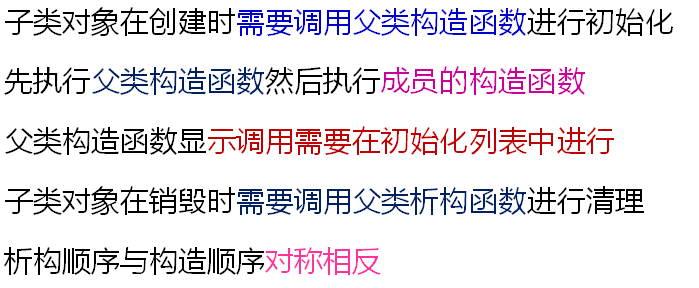思考:
如何初始化父类成员?
父类构造函数和子类构造函数有什么关系?
子类对象的构造:
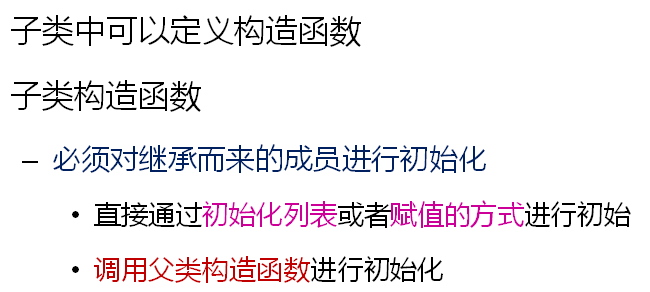
子类构造函数对继承而来的成员进行初始化有两种方式:
1、直接通过初始化列表或者赋值的方式进行初始化
2、调用父类构造函数进行初始化
父类构造函数在子类中的调用方式:
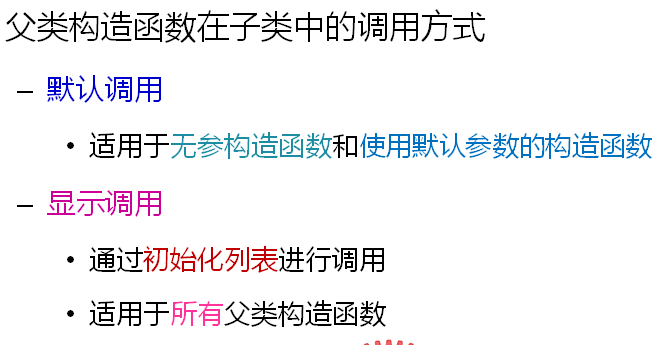
显式调用只能在初始化列表进行。
如下:
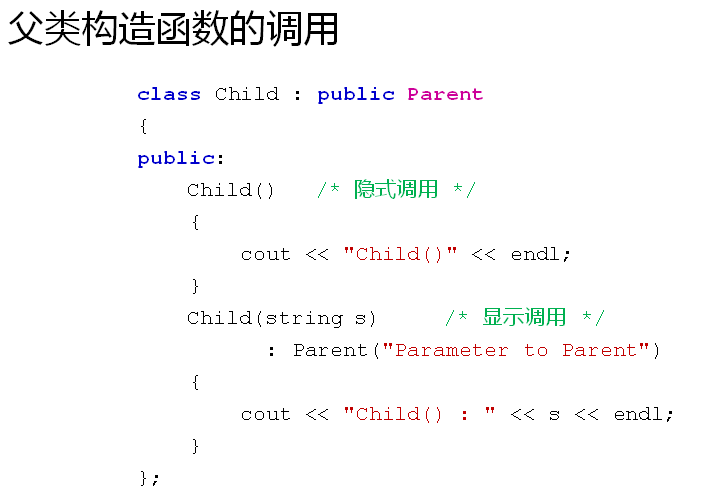
示例程序:

第30行会调用子类的无参构造函数Child(),而这个构造函数会默认调用父类的无参构造函数,因为父类没有默认构造函数,因此报错。
在父类中加上无参构造函数即可:

继续完善:
1 #include <iostream> 2 #include <string> 3 4 using namespace std; 5 6 class Parent 7 { 8 public: 9 Parent() 10 { 11 cout << "Parent()" << endl; 12 } 13 Parent(string s) 14 { 15 cout << "Parent(string s) : " << s << endl; 16 } 17 }; 18 19 class Child : public Parent 20 { 21 public: 22 Child() 23 { 24 cout << "Child()" << endl; 25 } 26 Child(string s) : Parent(s) 27 { 28 cout << "Child(string s) : " << s << endl; 29 } 30 }; 31 32 int main() 33 { 34 Child c; 35 Child cc("cc"); 36 37 return 0; 38 }
35行会触发26行的子类构造函数,在调用子类的构造函数前,先调用父类的Parent(string s)这个构造函数。
输出结果如下:

子类对象的构造:


深度解析:
1 #include <iostream> 2 #include <string> 3 4 using namespace std; 5 6 class Object 7 { 8 public: 9 Object(string s) 10 { 11 cout << "Object(string s) : " << s << endl; 12 } 13 }; 14 15 class Parent : public Object 16 { 17 public: 18 Parent() : Object("Default") 19 { 20 cout << "Parent()" << endl; 21 } 22 Parent(string s) : Object(s) 23 { 24 cout << "Parent(string s) : " << s << endl; 25 } 26 }; 27 28 class Child : public Parent 29 { 30 Object mO1; 31 Object mO2; 32 public: 33 Child() : mO1("Default 1"), mO2("Default 2") 34 { 35 cout << "Child()" << endl; 36 } 37 Child(string s) : Parent(s), mO1(s + " 1"), mO2(s + " 2") 38 { 39 cout << "Child(string s) : " << s << endl; 40 } 41 }; 42 43 int main() 44 { 45 Child cc("cc"); 46 47 return 0; 48 }
运行结果如下:
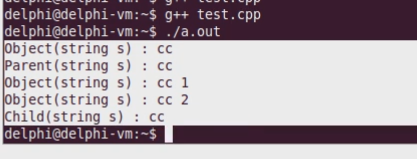
子类对象的析构:

示例程序:
1 #include <iostream> 2 #include <string> 3 4 using namespace std; 5 6 class Object 7 { 8 string ms; 9 public: 10 Object(string s) 11 { 12 cout << "Object(string s) : " << s << endl; 13 ms = s; 14 } 15 ~Object() 16 { 17 cout << "~Object() : " << ms << endl; 18 } 19 }; 20 21 class Parent : public Object 22 { 23 string ms; 24 public: 25 Parent() : Object("Default") 26 { 27 cout << "Parent()" << endl; 28 ms = "Default"; 29 } 30 Parent(string s) : Object(s) 31 { 32 cout << "Parent(string s) : " << s << endl; 33 ms = s; 34 } 35 ~Parent() 36 { 37 cout << "~Parent() : " << ms << endl; 38 } 39 }; 40 41 class Child : public Parent 42 { 43 Object mO1; 44 Object mO2; 45 string ms; 46 public: 47 Child() : mO1("Default 1"), mO2("Default 2") 48 { 49 cout << "Child()" << endl; 50 ms = "Default"; 51 } 52 Child(string s) : Parent(s), mO1(s + " 1"), mO2(s + " 2") 53 { 54 cout << "Child(string s) : " << s << endl; 55 ms = s; 56 } 57 ~Child() 58 { 59 cout << "~Child() " << ms << endl; 60 } 61 }; 62 63 int main() 64 { 65 Child cc("cc"); 66 67 cout << endl; 68 69 return 0; 70 }
执行结果如下:

小结:
